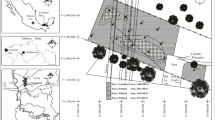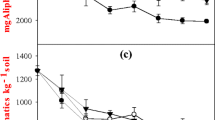Abstract
Much effort has been focused on defining the end-point of bioremediated soils by chemical analysis toxicity tests. However, these tests do not assess the quality, or the capability, of soil to support plant growth after bioremediation. We studied the response of plants to hydrocarbon contaminants by camparing barley (Hordeum vulgare) growth on: (i) control soil, agricultural topsoil, (ii) oil-contaminated soil (40,000 mg kg−1 total extractable hydrocarbons, or TEH), and (iii) oil-contaminated soil treated by bioremediation (20,000 mg kg−1 TEH). Barley growth and yield was significantly reduced by oil-contamination. Bioremediation did not improve yield of barley and shoot dry mass was slightly reduced after bioremediation. The lack of effect from bioremediation is attributed to poor soil water sorption, which was negatively influenced by hydrocarbon residuals. We concluded that the soil-water relation is one of the most important factors in assessing endpoint of bioremediated soils for plant growth.
Similar content being viewed by others
References
Biederbeck V O, St. Jacques R M, Curting D, Geissler H J, Selles F, Waddington J, Grove G and McNaughton D 1994 Use of heavy oil waste sludge for protection and improvement of sandy soil. Environment Canada Publication No. 379M0091. Environ. Can. Publ.
Blackburn J and Halker W R 1993 The impact of biochemistry, bioavailability and bioactivity on the selection of bioremediation techniques. Bioremedie 11, 328-333.
Bond R D 1968 Water repellent sands. In9th International Congress of Soil Science Transactions Vol. I. pp 339-346. International Society of Soil Science, Adelaide.
Canadian Council of Ministers of the Environment 1991 Interim Canadian Environmental Quality Criteria for Contaminated soils. CCME EPC-CS34.
Hendrickx J M H, Dekker L W and Boersama O H 1993 Unstable wetting fronts in water-repellent field soils. J. Environ. Qual. 22, 109-118.
Johnson R L and Danielson R M 1994 The bioremediation of salt and hydrocarbon contaminated topsoil. The bioreactor project: executive summary for 1992-93. CAPP report, Alberta Research Council, Vegreville.
King P M 1981 Comparison of methods for measuring severity of water repellence of sandy soils and assessment of some factors that affect its measurement. Aust. J. Soil Res. 9, 275-285.
Li X, Feng Y and Boersma L 1994 Partition of photosyntahtes between shoot and root in spring wheat (Triticum aestivumL.) as a function on soil water potential and root temperature. Plant Soil 164, 43-50.
McKeague J A (ed) 1978 Manual on soil sampling and methods of analysis. Subcommittee on Methods of Analysis of the Canada Soil Survey Committee, Ottawa. 212 p.
Mihelcic J R., Lueking J R, Mitzell R J and Stapleton J M 1993 Bioavailability of sorbed-and separated-phase chemicals. Biodegratation 4, 141-153.
Ritsema C J, Dekker LW, Hendrickx JMH and Hamminga W 1993 Preferential flow mechanismin a water repellent sandy soil. Water Resour. Res. 29, 2183–2193.
Ritsema C J and Dekker L W 1994 How water moves in a water repellent sandy soil 2. Dynamics of fingered flow. Water Resour. Res. 30, 2519-2531.
Sawatsky N and Li X 1997 Importance of soil-water relations in assessing the endpoint of bioremediated soils II. Water uptake and water-repellency in hydrocarbon contaminated soils. Plant Soil 192, 227-236.
Shepard S C, Evenden W G, Abboud S A and Stephenson M 1993 A plant life-cycle bioassay for contaminated soil, with comparison to other bioassays: mercury and zinc. Arch. Environ. Contam. Toxicol. 25, 27-35.
Visser S and Danielson R M 1995 Bioreactor project: Ecotoxicological testing of hydrocarbon and salt-contaminated wastes following bioremediation in a bioreactor. CAPP Publ. 1995-0004. CAPP.
Wang W 1991 Literature review on higher plants for toxicity testing. Water Air Soil Pollut. 59, 381-400.
Yeung P Y 1990 A method for measuring water-repellent soil. InProceedings of 27th Alberta Soil Science Workshop. pp 59–64. February 1990. Publisher, Edmonton, AB.
Yeung P Y P and Johnson R L (eds) 1996 The Bio-Reactor Project: Annual Report 1992-93. The Bioremediation of Salt and Hydrocarbon Contaminated Agricultural Topsoil. Alberta Environmental Centre, Vegreville, AB. 131 p.
Yeung P Y P, Johnson R L and Acharya S N 1994 An improved procedure for determining oil content in wet soil samples. InAnalysis of Soil Contaminated with Petroleum Constituents. Eds. T A O'Shay and K B Hoddinott. ASTM STP 1221. American Society for Testing and Materials, Philadelphia. 1221 p.
Author information
Authors and Affiliations
Rights and permissions
About this article
Cite this article
Li, X., Feng, Y. & Sawatsky, N. Importance of soil-water relations in assessing the endpoint of bioremediated soils. Plant and Soil 192, 219–226 (1997). https://doi.org/10.1023/A:1004280626976
Issue Date:
DOI: https://doi.org/10.1023/A:1004280626976




